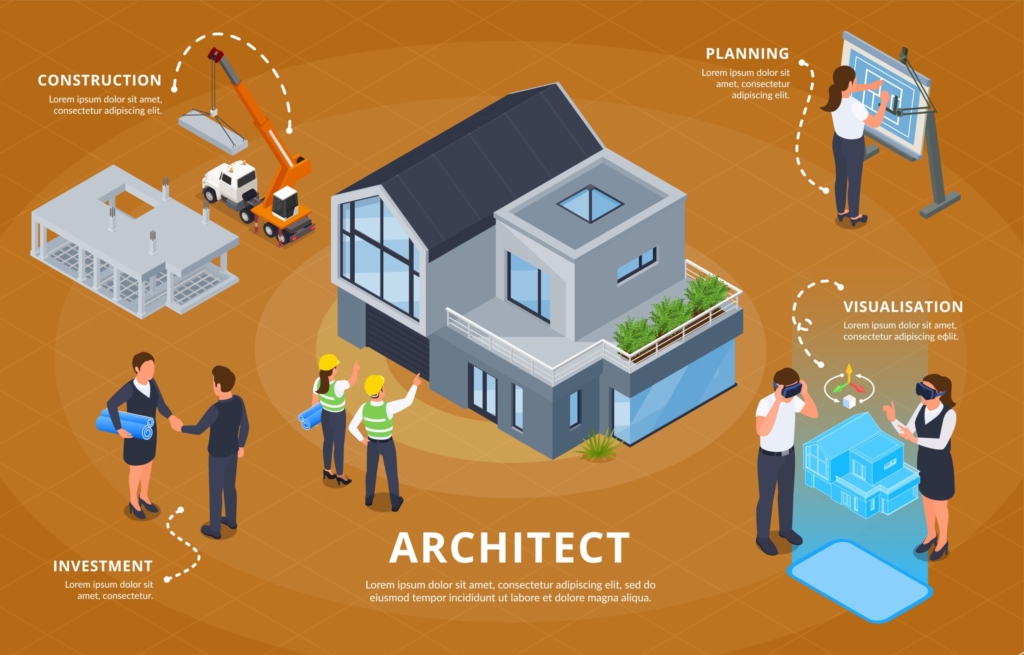How the AEC Industry is Shaping the Future of Construction Management:
Architecture:
We have a team of experienced staff available to provide software training in architectural design. Architects are the creative visionaries who design the overall form, function, and aesthetics of a building or structure. They take into consideration factors such as space planning, user needs, building codes, and aesthetics to create a functional and visually appealing design. Architects use software such as AutoCAD, Revit, and SketchUp to create drawings, models, and presentations. Please feel free to let us know how we can help you further in your journey of learning these software tools. We are here to assist you in any way we can.
Architect’s Role in AEC Projects:
Vision and Design: Architects play a crucial role in shaping the concept of a project by collaborating closely with clients to fully understand their requirements, program needs, and desired aesthetics. They excel in space planning and functionality, turning these needs into practical layouts that maximize space utilization and promote smooth flow within the building. Additionally, architects consider factors like lighting, ventilation, acoustics, and visual appeal to ensure that the space functions well and creates a pleasant user experience.
Technical Expertise: Creativity is crucial in architecture, but architects also have a solid understanding of technical aspects. They are knowledgeable in building codes, structural engineering principles, material properties, and construction methods. This knowledge ensures that their designs are not only aesthetically pleasing but also safe, practical to construct, and compliant with regulations. In addition, architects are skilled at creating comprehensive documentation, such as detailed drawings, 3D models, and specifications, to effectively communicate their design concepts with engineers, contractors, and other project stakeholders.
Aesthetics: We are committed to creating visually appealing spaces that enhance the overall user experience and are pleasing to the eye.
Benefits of Collaboration in AEC:
Feasible and Functional Designs: Collaborating early on with architects and engineers will help us create a design that is not only visually appealing, but also structurally sound and seamlessly integrates the necessary MEP systems.
Within the AEC (Architecture, Engineering, and Construction) industry, engineering disciplines play a crucial role in transforming the architect’s vision into a safe, functional, and buildable reality. Here’s a breakdown of the key engineering roles and how they contribute to the project:
Engineering: Our highly experienced staff specializes in teaching Civil engineers the essential skills needed to focus on foundations, structural integrity, and site development. We provide live learning opportunities for Mechanical engineers to design and oversee HVAC systems, plumbing, and other mechanical equipment. Our team also offers expertise in electrical engineering, teaching engineers how to design electrical systems, lighting, and communication infrastructure. Additionally, engineers at proficient in using specialized software for calculations, simulations, and creating detailed construction plans.
Engineering Disciplines in AEC:
Structural Engineering: The engineers play a crucial role in the project by ensuring that the building can withstand its own weight, environmental loads (such as wind, snow, and earthquakes), and meet its intended use. They are the backbone of the project. They analyse the architectural design, perform calculations, and specify the necessary structural elements like beams, columns, foundations, and slabs. They collaborate with architects to ensure the structural system integrates seamlessly with the overall design.
Mechanical, Electrical, and Plumbing (MEP) Engineering: This group concentrates on the unseen infrastructure that enables a building to operate effectively. Mechanical engineers are responsible for designing and specifying heating, ventilation, and air conditioning (HVAC) systems to guarantee occupant comfort and maintain optimal indoor air quality. Electrical engineers design the electrical systems, including power distribution, lighting systems, communication systems, and fire alarm systems. Plumbing engineers design the water supply, drainage, and sanitation systems, ensuring efficient water usage and proper waste disposal. MEP engineers work closely with architects to integrate these systems discreetly and efficiently within the building layout.
- Civil Engineering
- Other Engineering Specialties
3.Geotechnical engineers
4. Acoustical engineers
5. Technical Expertise
6. Problem-Solving and Innovation
7. Collaboration and Communication
Benefits of Strong Engineering in AEC: Safety and Structural Integrity: A well-engineered building is safe for occupants and can withstand various environmental loads.
1.Functionality and Efficiency
2.Cost-Effectiveness
3.Sustainable Designs
Construction: We have well experienced Professionals in Construction learning as well as responsible for Live building the project based on the architect’s and engineer’s plans.
We help to learn manage a team of skilled workers like carpenters, electricians, plumbers, and welders to bring the design to life.
We provide BIM Construction software’s it helps to do professionals rely on blueprints, specifications, and project schedules to ensure the project is built according to plan, on time, and within budget.
How They Work Together:
These three disciplines work collaboratively throughout the project lifecycle:
1.Planning and Design
2.Construction
3.Operation and Maintenance
Beyond Design and Construction:
1.Facility management
2.Landscaping
3.Interior design
Key Players in AEC Construction:
1.Project management
2.General Contractors (GCs
3.Subcontractors
4.Electrical contractors
5.Plumbing contractors
6.HVAC contractors
7.Carpentry contractors
8.Concrete contractors
9.Many other specialties
10.Site Preparation
Building Construction: The framework, walls, roof, and exterior finishes are constructed according to the architectural and engineering plans. MEP (Mechanical, Electrical, Plumbing) Installation: Subcontractors install the building’s essential infrastructure systems.
1.Interior Finishing: This includes installing drywall, flooring, ceilings, painting, and other interior elements.
2.Quality Control and Inspections: Throughout the construction process, inspections are conducted to ensure the work meets quality standards and adheres to building codes. Project Handover: Once construction is complete and all inspections are passed, the project is handed over to the owner.
The Importance of AEC Construction:
Transforming Designs into Reality: Construction professionals take the architect’s vision and the engineer’s technical specifications and translate them into a tangible, functional structure.
Safety and Quality: Construction professionals ensure the building is constructed safely and adheres to all building codes and safety regulations. They also implement quality control measures to ensure the building meets the required standards.
Budget and Schedule Management: Skilled construction management keeps the project on track with the budget and timeline to avoid cost overruns and delays.
Collaboration is Key: In order to achieve successful construction projects, seamless collaboration is key among the general contractor, subcontractors, architects, engineers, and other stakeholders.
The Future of AEC Construction: Advancements in technology are impacting the construction phase as well. Here are some trends shaping the future:
BIM (Building Information Modelling): Our professional staff helps you to Creates a digital model of the entire building, facilitating better planning, clash detection, and communication across all disciplines.
Modular Construction: Prefabricating building components off-site can improve efficiency, quality control, and reduce on-site construction time.
Robotics and Automation: I believe that the AEC industry has a bright future with the use of robots to automate repetitive tasks such as bricklaying or welding. This will not only improve safety but also boost productivity.
Drones: Most popular companies are using drones for site surveys, progress monitoring, and even automated inspections.




